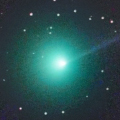
|
Now it is 8.2 mag (Oct. 12, Virgilio Gonano). It will fade out rapidly after this. It will be fainter than 18 mag in January. It will never be observable after this.
Date(TT) R.A. (2000) Decl. Delta r Elong. m1 Best Time(A, h)
Oct. 14 11 58.02 3 23.2 1.086 0.408 22 7.7 4:40 (269, 4)
Oct. 21 12 50.53 -5 15.0 1.222 0.342 13 7.5 4:46 (273, -5)
|
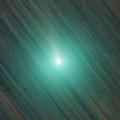
|
Now it is 8.3 mag (Oct. 12, Virgilio Gonano). It will fade out rapidly after this. In the Northern Hemisphere, it stays observable in good condition. In the Southern Hemisphere, it will be getting higher gradually.
Date(TT) R.A. (2000) Decl. Delta r Elong. m1 Best Time(A, h)
Oct. 14 7 34.68 19 47.5 0.410 1.064 87 7.5 4:40 (303, 66)
Oct. 21 7 59.45 13 59.0 0.431 1.071 87 7.5 4:46 (315, 63)
|
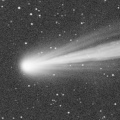
|
It approached to Sun down to 0.23 a.u. and brightened up to 2.5 mag in mid September (Sept. 18, Juan Jose Gonzalez). Fading rapidly. It will be fainter than 18 mag in January. Now it is not observable. It will appear soon in the Southern Hemisphere, or in November in the Northern Hemisphere.
Date(TT) R.A. (2000) Decl. Delta r Elong. m1 Best Time(A, h)
Oct. 14 12 56.12 -23 23.6 1.716 0.807 16 9.2 4:40 (284,-23)
Oct. 21 12 55.78 -26 52.0 1.841 0.962 19 10.2 4:46 (291,-18)
|

|
It brightened very rapidly. It will approach to Earth down to 0.2 a.u. in November, and it is expected to brighten up to 7.5 mag. Now it is 10.8 mag (Oct. 7, Bob King). It will turn to fade out rapidly after brightening. In the Northern Hemisphere, it will be unobservable in January. But it will be observable again in October. In the Southern Hemisphere, it is not observable now, but it will appear in November.
Date(TT) R.A. (2000) Decl. Delta r Elong. m1 Best Time(A, h)
Oct. 14 12 20.03 46 53.1 0.994 0.936 56 10.7 4:40 (228, 23)
Oct. 21 12 40.10 48 17.3 0.770 0.907 60 10.0 4:46 (228, 26)
|

|
Now it is 9.8 mag (Oct. 10, Juan Jose Gonzalez). Fading gradually. In the Northern Hemisphere, it will be unobservable in January. In the Southern Hemisphere, it stays observable in good condition.
Date(TT) R.A. (2000) Decl. Delta r Elong. m1 Best Time(A, h)
Oct. 14 0 57.06 -37 46.1 2.067 2.854 134 10.1 23:24 ( 0, 17)
Oct. 21 0 37.26 -39 57.5 2.185 2.902 127 10.3 22:37 ( 0, 15)
|
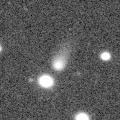
|
It is expected to brighten up to 7 mag in early 2024. Now it is 12.3 mag (Sept. 16, Jose G. S. Aguiar). It will brighten rapidly after this. In the Northern Hemisphere, it is not observable now, but it will appear in November. It locates somewhat low in the Southern Hemisphere. But it will become high in winter. The brightness evolution slowed down since May.
Date(TT) R.A. (2000) Decl. Delta r Elong. m1 Best Time(A, h)
Oct. 14 10 35.54 -34 28.5 2.781 2.193 45 10.6 4:40 (311, -3)
Oct. 21 10 54.39 -35 34.1 2.701 2.121 45 10.4 4:46 (313, -2)
|
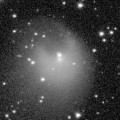
|
It returns for the first time in 70 years. It will brighten up to 4.5 mag in 2024 spring. It suddenly brightened in outburst by 5 mag up to 11.5 mag on July 20 (E. Tamas, Francois Kugel). It brightened again in another outburst up to 11.7 mag on Oct. 5 (Richard Miles). Now it is 11.8 mag (Oct. 11, Osamu Miyazaki). It will brighten rapidly after this. In the Northern Hemisphere, it stays observable in good condition. In the Southern Hemisphere, it is not observable now.
Date(TT) R.A. (2000) Decl. Delta r Elong. m1 Best Time(A, h)
Oct. 14 17 26.27 44 36.2 3.019 2.960 77 11.4 18:51 (119, 56)
Oct. 21 17 31.47 43 27.6 2.968 2.879 75 11.4 18:43 (118, 53)
|

|
It will fade out rapidly after this. It will be fainter than 18 mag in January. Now it is not observable. It will appear in November.
Date(TT) R.A. (2000) Decl. Delta r Elong. m1 Best Time(A, h)
Oct. 14 12 15.16 -6 5.2 1.122 0.298 14 14.0 4:40 (274, -5)
Oct. 21 13 50.68 -12 56.1 1.119 0.140 3 11.5 18:43 ( 85,-16)
|

|
It brightened up to 8 mag from 2022 summer to 2023 spring. Now it is 12.5 mag (Oct. 13, Osamu Miyazaki). Fading slowly. It stays observable in good condition.
Date(TT) R.A. (2000) Decl. Delta r Elong. m1 Best Time(A, h)
Oct. 14 6 47.57 -8 17.7 3.684 3.906 95 12.1 4:40 (346, 46)
Oct. 21 6 44.77 -8 15.9 3.641 3.969 101 12.1 4:46 (359, 47)
|

|
It brightened up to 7.8 mag in late July (July 20, Thomas Lehmann). Now it is 12.9 mag (Oct. 3, Chris Wyatt). Fading slowly. In the Northern Hemisphere, it is not observable now, but it will appear in November. In the Southern Hemisphere, it will be unobservable in December. But it will be observable again in December.
Date(TT) R.A. (2000) Decl. Delta r Elong. m1 Best Time(A, h)
Oct. 14 14 56.56 -12 14.1 2.655 1.807 25 12.2 18:51 ( 75, 0)
Oct. 21 14 58.82 -11 42.0 2.773 1.862 19 12.4 18:43 ( 78, -3)
|
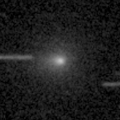
|
Now it is 12.6 mag (Oct. 3, Chris Wyatt). It will fade out rapidly after this. In the Northern Hemisphere, it will be getting higher gradually. It locates somewhat low in the Southern Hemisphere.
Date(TT) R.A. (2000) Decl. Delta r Elong. m1 Best Time(A, h)
Oct. 14 16 55.81 -5 44.4 1.257 1.067 55 12.8 18:51 ( 60, 27)
Oct. 21 17 27.71 -5 29.2 1.227 1.071 56 12.7 18:43 ( 58, 30)
|

|
Now it is 13.7 mag (July 14, Chris Wyatt). It stays 13 mag for a while. It stays extremely low in the Northern Hemisphere. In the Southern Hemisphere, it will be getting higher gradually.
Date(TT) R.A. (2000) Decl. Delta r Elong. m1 Best Time(A, h)
Oct. 14 10 45.25 -23 44.2 4.762 4.035 39 13.2 4:40 (301, 2)
Oct. 21 10 46.02 -25 14.6 4.722 4.063 43 13.2 4:46 (307, 6)
|
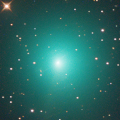
|
It brightened up to 8.4 mag in late July (July 22, Thomas Lehmann). Now it is 12.0 mag (Oct. 6, Osamu Miyazaki). Fading rapidly. It will be fainter than 18 mag in December. It stays observable in good condition.
Date(TT) R.A. (2000) Decl. Delta r Elong. m1 Best Time(A, h)
Oct. 14 22 34.61 -23 50.4 1.104 1.904 129 13.3 21:05 ( 0, 31)
Oct. 21 22 40.86 -24 48.0 1.249 1.985 123 13.8 20:43 ( 0, 30)
|

|
It is expected to brighten up to 7 mag, and it will be observable in good condition in winter. Now it is 14.4 mag (Oct. 2, Ken-ichi Kadota). Brightening rapidly. In the Northern Hemisphere, it stays observable in good condition. It locates somewhat low in the Southern Hemisphere. But it will become high in winter.
Date(TT) R.A. (2000) Decl. Delta r Elong. m1 Best Time(A, h)
Oct. 14 6 44.49 21 56.9 0.992 1.522 99 14.6 4:40 (326, 75)
Oct. 21 7 8.01 21 56.8 0.917 1.479 101 13.5 4:46 (334, 76)
|

|
It brightened up to 8.3 mag in 2021-2022 winter (Jan. 6, 2022, Toshiyuki Takahashi). Now it is 13.2 mag (July 14, Chris Wyatt). It stays 14 mag for a while. In the Northern Hemisphere, it is not observable now, but it will appear in November. In the Southern Hemisphere, it will be getting higher gradually.
Date(TT) R.A. (2000) Decl. Delta r Elong. m1 Best Time(A, h)
Oct. 14 10 57.49 -38 40.2 7.207 6.519 43 13.8 4:40 (311,-10)
Oct. 21 11 2.26 -39 35.8 7.223 6.564 45 13.8 4:46 (315, -6)
|
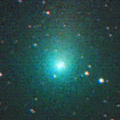
|
It brightened up to 9.5 mag from last winter to early spring (Jan. 30, Katsumi Yoshimoto). Now it is 13.0 mag (Oct. 6, Osamu Miyazaki). It will fade out rapidly after this. It will be getting lower gradually after this, and it will be unobservable in February.
Date(TT) R.A. (2000) Decl. Delta r Elong. m1 Best Time(A, h)
Oct. 14 22 47.14 -2 41.5 2.511 3.352 141 13.8 21:16 ( 0, 52)
Oct. 21 22 41.69 -4 55.0 2.660 3.417 132 14.1 20:43 ( 0, 50)
|

|
Now it is 12.2 mag (Sept. 23, Toshiyuki Takahashi). In the Northern Hemisphere, it stays observable in good condition. It locates somewhat low in the Southern Hemisphere.
Date(TT) R.A. (2000) Decl. Delta r Elong. m1 Best Time(A, h)
Oct. 14 8 35.50 21 11.0 6.340 6.144 74 13.9 4:40 (283, 55)
Oct. 21 8 38.16 20 59.7 6.231 6.146 80 13.9 4:46 (291, 61)
|
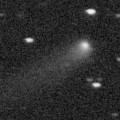
|
Now it is 13.8 mag (Oct. 3, Chris Wyatt). Fading gradually. In the Northern Hemisphere, it stays observable in good condition. In the Southern Hemisphere, it will be getting lower gradually after this, and it will be unobservable in January.
Date(TT) R.A. (2000) Decl. Delta r Elong. m1 Best Time(A, h)
Oct. 14 23 51.38 5 10.2 2.544 3.495 159 14.0 22:19 ( 0, 60)
Oct. 21 23 35.61 4 37.7 2.632 3.520 148 14.1 21:36 ( 0, 60)
|

|
Now it is 14.3 mag (Oct. 3, Chris Wyatt). It stays 15 mag for a while. In the Northern Hemisphere, it is not observable now. In the Southern Hemisphere, it stays observable in good condition. It was expected to brighten up to 10 mag from spring to summer. However, it was fainter than originally expected.
Date(TT) R.A. (2000) Decl. Delta r Elong. m1 Best Time(A, h)
Oct. 14 11 58.17 -76 44.7 3.652 3.435 69 14.0 4:40 (344,-33)
Oct. 21 12 1.48 -77 39.0 3.705 3.465 68 14.1 4:46 (346,-32)
|

|
The ATLAS search program detected its cometary activity in April. It continues to be brightening even after the perihelion passage. Now it is 13.9 mag (Oct. 3, Chris Wyatt). It will fade out rapidly after this. It will be fainter than 18 mag in January. It stays observable in good condition.
Date(TT) R.A. (2000) Decl. Delta r Elong. m1 Best Time(A, h)
Oct. 14 23 33.01 -25 44.8 2.354 3.170 138 14.0 22:02 ( 0, 29)
Oct. 21 23 31.51 -24 58.4 2.446 3.206 132 14.3 21:33 ( 0, 30)
|
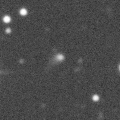
|
Now it is 14.5 mag (Oct. 2, Ken-ichi Kadota). Brightening slowly. In the Northern Hemisphere, it stays observable in good condition. In the Southern Hemisphere, it will be getting higher gradually. It is expected to brighten up to 12 mag from 2024 to 2025.
Date(TT) R.A. (2000) Decl. Delta r Elong. m1 Best Time(A, h)
Oct. 14 9 41.18 4 36.6 5.213 4.705 54 14.2 4:40 (289, 32)
Oct. 21 9 42.38 4 51.9 5.067 4.668 61 14.1 4:46 (295, 38)
|
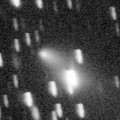
|
It brightened up to 13.6 mag in summer (July 16, Mitsunori Tsumura). Now it is 14.5 mag (Sept. 26, Thomas Lehmann). It will fade out rapidly after this. It will be fainter than 18 mag in February. In the Northern Hemisphere, it stays observable in good condition. In the Southern Hemisphere, it will never be observable after this.
Date(TT) R.A. (2000) Decl. Delta r Elong. m1 Best Time(A, h)
Oct. 14 1 22.34 68 48.6 1.342 2.023 119 14.4 23:49 (180, 56)
Oct. 21 0 51.85 70 10.2 1.379 2.062 119 14.6 22:51 (180, 55)
|
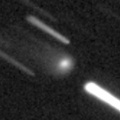
|
Now it is 14.9 mag (Sept. 18, Ken-ichi Kadota). Brightening slowly. In the Northern Hemisphere, it will be unobservable in November. But it will be observable again in December. In the Southern Hemisphere, it is not observable now, but it will appear in December. It is expected to brighten up to 12.5 mag in 2024 spring. At the high light, it will be observable in excellent condition in the Southern Hemisphere, but it will be low in the Northern Hemisphere.
Date(TT) R.A. (2000) Decl. Delta r Elong. m1 Best Time(A, h)
Oct. 14 15 9.55 -3 20.4 3.944 3.110 29 14.7 18:51 ( 80, 8)
Oct. 21 15 11.08 -4 41.1 3.965 3.075 23 14.7 18:43 ( 82, 4)
|
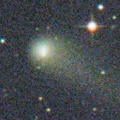
|
It brightened up to 11.1 mag in early 2022 (Mar. 31, 2022, F. Kugel, J.-G. Bosch, J. Nicolas). Now it is 14.0 mag (Sept. 22, S. Shurpakov). It stays 15 mag for a while. It locates somewhat low in the Northern Hemisphere. But it will become high in winter. In the Southern Hemisphere, it is not observable now, but it will appear in February.
Date(TT) R.A. (2000) Decl. Delta r Elong. m1 Best Time(A, h)
Oct. 14 15 55.08 16 26.8 6.451 5.811 46 14.7 18:51 ( 91, 28)
Oct. 21 16 0.63 16 11.4 6.527 5.848 43 14.7 18:43 ( 92, 25)
|

|
Now it is 15.2 mag (July 22, ATLAS Chile). It stays 15 mag for a while. In the Northern Hemisphere, it is not observable now, but it will appear in November. In the Southern Hemisphere, it will be getting higher gradually.
Date(TT) R.A. (2000) Decl. Delta r Elong. m1 Best Time(A, h)
Oct. 14 11 8.34 -30 20.8 6.351 5.587 37 15.0 4:40 (303, -6)
Oct. 21 11 14.98 -30 54.8 6.296 5.563 39 14.9 4:46 (307, -2)
|

|
It will approach to Sun down to 0.4 a.u. in late September in 2024, and it is expected to brighten up to 0 mag. Now it is 15.3 mag (Sept. 10, A. Ivanov et al.). Brightening gradually. Now it is not observable. It will appear in November in the Northern Hemisphere, or in December in the Southern Hemisphere. At the high light, in the Northern Hemisphere, it will be observable in good condition after the perihelion passage. In the Southern Hemisphere, it will be observable in the low sky before and after the perihelion passage.
Date(TT) R.A. (2000) Decl. Delta r Elong. m1 Best Time(A, h)
Oct. 14 14 20.11 -2 49.4 6.045 5.100 17 15.5 18:51 ( 88, -2)
Oct. 21 14 23.48 -3 18.9 5.993 5.028 12 15.4 18:43 ( 90, -5)
|

|
Now it is 14.3 mag (July 7, Thomas Lehmann). It stays 16 mag for a while. In the Northern Hemisphere, it is not observable now, but it will appear in January. It stays extremely low in the Southern Hemisphere. But it will become high in winter.
Date(TT) R.A. (2000) Decl. Delta r Elong. m1 Best Time(A, h)
Oct. 14 13 18.55 -49 23.4 3.479 2.812 41 15.5 18:51 ( 50,-35)
Oct. 21 13 36.59 -49 20.7 3.571 2.866 38 15.5 4:46 (310,-34)
|

|
It has not been observed yet in this apparition. It was expected to brighten rapidly up to 15 mag in summer. But actually, it is not detected, fainter than 19 mag (Aug. 12, Martin Masek). Fading slowly. It locates somewhat low in the Northern Hemisphere. In the Southern Hemisphere, it will be getting lower gradually after this, and it will be unobservable in January.
Date(TT) R.A. (2000) Decl. Delta r Elong. m1 Best Time(A, h)
Oct. 14 18 27.00 -24 24.4 1.981 1.993 76 15.5 18:51 ( 28, 25)
Oct. 21 18 41.69 -23 39.6 2.045 1.987 72 15.5 18:43 ( 30, 25)
|

|
It is expected to brighten up to 14.5 mag in winter. Now it is 16.5 mag (Oct. 6, ATLAS-HKO, Haleakala). It stays 15 mag for a while. It stays observable in good condition.
Date(TT) R.A. (2000) Decl. Delta r Elong. m1 Best Time(A, h)
Oct. 14 3 30.37 15 30.4 1.713 2.599 145 15.6 2:03 ( 0, 71)
Oct. 21 3 27.41 15 42.6 1.635 2.564 153 15.5 1:33 ( 0, 71)
|

|
David Rankin detected its cometary activity in June. Now it is 15.7 mag (Sept. 24, Ken-ichi Kadota). Fading slowly. It stays observable in good condition.
Date(TT) R.A. (2000) Decl. Delta r Elong. m1 Best Time(A, h)
Oct. 14 22 5.97 -4 16.8 1.422 2.214 131 15.6 20:36 ( 0, 51)
Oct. 21 22 8.37 -4 12.4 1.465 2.196 125 15.6 20:11 ( 0, 51)
|
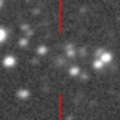
|
Now it is 14.6 mag (Aug. 5, J. L. Virlichie, P. Traverse, H. Roy, G. Houdin). Fading slowly. It will be unobservable in January.
Date(TT) R.A. (2000) Decl. Delta r Elong. m1 Best Time(A, h)
Oct. 14 18 39.93 -34 27.6 2.981 2.950 78 15.6 18:51 ( 21, 17)
Oct. 21 18 49.78 -34 34.2 3.078 2.958 73 15.7 18:43 ( 23, 16)
|

|
It approached to Earth down to 0.29 a.u. in early February, and it brightened up to 4.5 mag (Feb. 1, Juan Jose Gonzalez). Now it is 16.1 mag (Oct. 4, ATLAS Chile). Fading slowly. In the Northern Hemisphere, it will be unobservable soon. In the Southern Hemisphere, it stays observable in good condition.
Date(TT) R.A. (2000) Decl. Delta r Elong. m1 Best Time(A, h)
Oct. 14 6 23.25 -53 1.4 3.684 3.838 91 15.7 4:40 (358, 2)
Oct. 21 6 14.45 -55 15.0 3.726 3.911 93 15.8 4:19 ( 0, 0)
|

|
It is expected to brighten up to 14 mag in 2024 summer. At the high light, it is not observable in the Northern Hemisphere. Now it is 16.5 mag (Oct. 6, Jean-Claude Merlin). It stays 16 mag for a while. In the Southern Hemisphere, it stays observable in good condition.
Date(TT) R.A. (2000) Decl. Delta r Elong. m1 Best Time(A, h)
Oct. 14 3 10.52 -12 23.1 3.062 3.919 144 15.9 1:43 ( 0, 43)
Oct. 21 3 3.45 -14 47.9 2.996 3.873 147 15.8 1:09 ( 0, 40)
|

|
It brightened up to 11.8 mag in summer (June 17, Osamu Miyazaki). Now it is 14.9 mag (Sept. 28, Ken-ichi Kadota). It will fade out rapidly after this. It will be fainter than 18 mag in December. In the Northern Hemisphere, it stays observable in good condition. In the Southern Hemisphere, it will be getting lower gradually.
Date(TT) R.A. (2000) Decl. Delta r Elong. m1 Best Time(A, h)
Oct. 14 20 3.44 -2 57.1 1.893 2.313 101 15.8 18:51 ( 7, 52)
Oct. 21 20 12.15 -3 7.3 1.995 2.340 97 16.1 18:43 ( 11, 51)
|
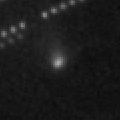
|
It brightened very rapidly. Now it is 15.2 mag (Aug. 23, ATLAS South Africa). It will fade out rapidly after this. It will be fainter than 18 mag in December. Now it is not observable. It will appear in November in the Northern Hemisphere. In the Southern Hemisphere, it will never be observable after this.
Date(TT) R.A. (2000) Decl. Delta r Elong. m1 Best Time(A, h)
Oct. 14 14 22.57 -16 51.2 3.004 2.085 18 15.8 18:51 ( 76, -9)
Oct. 21 14 27.10 -15 39.3 3.065 2.104 12 16.1 18:43 ( 79,-11)
|
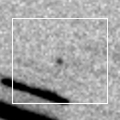
|
It is expected to brighten up to 8.5 mag from January to February. Now it is 19.1 mag (Sept. 26, P. Carson). Brightening rapidly. It stays observable in good condition.
Date(TT) R.A. (2000) Decl. Delta r Elong. m1 Best Time(A, h)
Oct. 14 3 2.31 21 21.4 0.876 1.813 150 16.4 1:35 ( 0, 76)
Oct. 21 3 2.47 21 9.8 0.806 1.767 157 15.9 1:08 ( 0, 76)
|
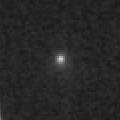
|
It is expected to brighten up to 15 mag from autumn to winter. Now it is 16.6 mag (Oct. 4, ATLAS Chile). It stays 16 mag for a while. In the Northern Hemisphere, it is not observable now, but it will be observable soon. In the Southern Hemisphere, it stays observable in good condition.
Date(TT) R.A. (2000) Decl. Delta r Elong. m1 Best Time(A, h)
Oct. 14 1 48.97 -56 56.2 1.255 1.903 114 16.2 0:23 ( 0, -2)
Oct. 21 1 31.03 -54 51.3 1.233 1.881 114 16.0 23:31 ( 0, 0)
|

|
Now it is 15.8 mag (Oct. 5, ATLAS Chile). Fading slowly. It stays observable in good condition.
Date(TT) R.A. (2000) Decl. Delta r Elong. m1 Best Time(A, h)
Oct. 14 0 16.43 -8 28.3 2.764 3.709 158 16.0 22:45 ( 0, 47)
Oct. 21 0 12.53 -8 35.7 2.822 3.725 151 16.1 22:14 ( 0, 47)
|
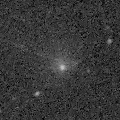
|
Very large comet. It is expected to brighten up to 13 mag in 2031. Now it is 16.4 mag (Sept. 28, ATLAS Chile). It stays 16 mag for a while. In the Northern Hemisphere, it is not observable now. In the Southern Hemisphere, it stays observable in good condition. In the Northern Hemisphere, it is not observable until 2030.
Date(TT) R.A. (2000) Decl. Delta r Elong. m1 Best Time(A, h)
Oct. 14 3 26.12 -65 3.5 16.874 17.128 103 16.1 1:58 ( 0,-10)
Oct. 21 3 23.57 -65 21.1 16.871 17.103 101 16.1 1:28 ( 0,-10)
|
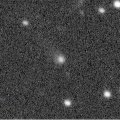
|
Now it is 16.5 mag (Apr. 10, Michael Jager). It stays 16 mag for a while. In the Northern Hemisphere, it will be unobservable in November. In the Southern Hemisphere, it stays observable in good condition.
Date(TT) R.A. (2000) Decl. Delta r Elong. m1 Best Time(A, h)
Oct. 14 9 36.52 -38 49.1 4.142 3.706 57 16.3 4:40 (322, 2)
Oct. 21 9 39.03 -41 22.5 4.088 3.709 60 16.2 4:46 (328, 3)
|

|
It brightened up to 14.1 mag in 2022 spring (Mar. 22, 2022, Chris Wyatt). Now it is 16.3 mag (Oct. 6, Jean-Claude Merlin). Fading slowly. It stays observable in good condition.
Date(TT) R.A. (2000) Decl. Delta r Elong. m1 Best Time(A, h)
Oct. 14 2 17.47 -2 38.5 4.454 5.407 161 16.4 0:51 ( 0, 52)
Oct. 21 2 10.14 -2 35.1 4.487 5.455 165 16.4 0:16 ( 0, 53)
|
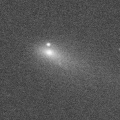
|
It brightened up to 12.8 mag in spring (Mar. 8, Taras Prystavski). Now it is 16.1 mag (Sept. 13, Ken-ichi Kadota). It will fade out rapidly after this. It will be fainter than 18 mag in November. It stays observable in good condition.
Date(TT) R.A. (2000) Decl. Delta r Elong. m1 Best Time(A, h)
Oct. 14 0 52.34 -5 58.9 1.736 2.712 165 16.5 23:21 ( 0, 49)
Oct. 21 0 46.09 -6 7.3 1.798 2.749 158 16.7 22:47 ( 0, 49)
|

|
Now it is 16.2 mag (Sept. 13, ATLAS South Africa). Fading slowly. It will be fainter than 18 mag in December. It locates somewhat low in the Northern Hemisphere. In the Southern Hemisphere, it will be getting lower gradually after this, and it will be unobservable in December.
Date(TT) R.A. (2000) Decl. Delta r Elong. m1 Best Time(A, h)
Oct. 14 17 59.28 -22 0.2 3.212 3.016 69 16.7 18:51 ( 36, 24)
Oct. 21 18 8.29 -22 4.8 3.340 3.054 64 16.9 18:43 ( 38, 23)
|
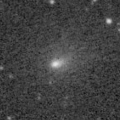
|
Now it is 16.7 mag (Sept. 5, Thomas Lehmann). It will fade out rapidly after this. It will be fainter than 18 mag in November. It locates somewhat low in the Northern Hemisphere. In the Southern Hemisphere, it will be getting lower gradually.
Date(TT) R.A. (2000) Decl. Delta r Elong. m1 Best Time(A, h)
Oct. 14 18 56.52 -30 30.3 1.992 2.105 82 16.7 18:51 ( 19, 22)
Oct. 21 19 1.31 -32 24.4 2.182 2.173 76 17.1 18:43 ( 22, 19)
|
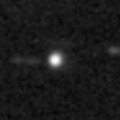
|
Now it is 16.6 mag (Sept. 18, Ken-ichi Kadota). Fading slowly. It will be fainter than 18 mag in January. In the Northern Hemisphere, it stays observable in good condition. In the Southern Hemisphere, it will be getting lower gradually. It was very faint as 21.5 mag in 2021. It seems to be bright temporarily in outburst.
Date(TT) R.A. (2000) Decl. Delta r Elong. m1 Best Time(A, h)
Oct. 14 21 6.62 -12 0.4 4.074 4.591 115 16.7 19:37 ( 0, 43)
Oct. 21 21 7.53 -11 57.3 4.188 4.605 108 16.8 19:10 ( 0, 43)
|

|
Very far object. Now it is 16.7 mag (Sept. 15, J. L. Virlichie, P. Traverse, H. Roy). It stays 17 mag for a while. In the Northern Hemisphere, it is not observable now. In the Southern Hemisphere, it stays observable in good condition.
Date(TT) R.A. (2000) Decl. Delta r Elong. m1 Best Time(A, h)
Oct. 14 5 16.75 -75 50.3 10.280 10.314 89 16.8 3:47 ( 0,-21)
Oct. 21 5 5.32 -76 22.7 10.296 10.314 88 16.8 3:09 ( 0,-21)
|
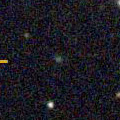
|
Now it is 17.2 mag (Sept. 26, ATLAS-HKO, Haleakala). It stays 17 mag for a while. In the Northern Hemisphere, it stays observable in good condition. It stays extremely low in the Southern Hemisphere.
Date(TT) R.A. (2000) Decl. Delta r Elong. m1 Best Time(A, h)
Oct. 14 5 2.38 40 20.1 6.156 6.710 119 16.8 3:35 (180, 85)
Oct. 21 5 1.89 40 39.4 6.068 6.706 126 16.8 3:07 (180, 84)
|
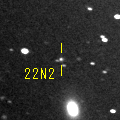
|
It is expected to brighten up to 11.5 mag in 2025 autumn, and it will be observable in good condition. Now it is 17.0 mag (Sept. 22, ATLAS South Africa). It stays 17 mag for a while. It will be getting lower gradually after this, and it will be unobservable in January.
Date(TT) R.A. (2000) Decl. Delta r Elong. m1 Best Time(A, h)
Oct. 14 20 32.51 -19 26.3 6.309 6.646 105 16.8 19:03 ( 0, 36)
Oct. 21 20 33.19 -19 20.6 6.378 6.603 98 16.8 18:43 ( 2, 36)
|

|
Now it is 16.6 mag (Sept. 27, ATLAS Chile). It stays 17 mag for a while. It stays observable in good condition.
Date(TT) R.A. (2000) Decl. Delta r Elong. m1 Best Time(A, h)
Oct. 14 4 58.76 -11 46.9 6.846 7.407 120 16.9 3:31 ( 0, 43)
Oct. 21 4 57.88 -12 3.9 6.745 7.375 126 16.8 3:03 ( 0, 43)
|
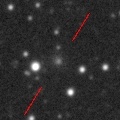
|
Now it is 17.2 mag (Oct. 3, ATLAS South Africa). It stays 17 mag for a while. It will be getting lower gradually after this, and it will be unobservable in January in the Northern Hemisphere, or in December in the Southern Hemisphere.
Date(TT) R.A. (2000) Decl. Delta r Elong. m1 Best Time(A, h)
Oct. 14 18 29.07 -12 30.1 2.509 2.490 77 16.8 18:51 ( 34, 36)
Oct. 21 18 38.97 -12 34.5 2.577 2.475 72 16.9 18:43 ( 36, 35)
|
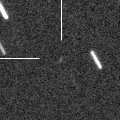
|
Now it is 17.7 mag (July 12, A. Diepvens). It stays 16 mag for a while. In the Northern Hemisphere, it will be getting higher gradually. In the Southern Hemisphere, it is not observable now, but it will appear in November.
Date(TT) R.A. (2000) Decl. Delta r Elong. m1 Best Time(A, h)
Oct. 14 11 48.42 16 40.1 2.848 2.075 32 16.9 4:40 (259, 13)
Oct. 21 11 50.82 14 12.5 2.780 2.068 36 16.9 4:46 (265, 18)
|

|
Now it is 17.0 mag (Sept. 28, A. Diepvens). Fading slowly. It will be fainter than 18 mag in January. It stays observable in good condition.
Date(TT) R.A. (2000) Decl. Delta r Elong. m1 Best Time(A, h)
Oct. 14 3 57.25 6 19.7 2.253 3.080 139 17.0 2:30 ( 0, 61)
Oct. 21 3 54.73 5 50.7 2.213 3.092 146 17.0 2:00 ( 0, 61)
|

|
The cometary activity was detected by Masayoshi Yoshimi on Sept. 15. Now it is 16.0 mag (Sept. 15, Masayoshi Yoshimi). It will fade out rapidly after this. It will be fainter than 18 mag in November. In the Northern Hemisphere, it stays observable in good condition. In the Southern Hemisphere, it will be unobservable soon.
Date(TT) R.A. (2000) Decl. Delta r Elong. m1 Best Time(A, h)
Oct. 14 21 18.58 45 21.1 0.243 1.129 117 17.0 19:48 (180, 79)
Oct. 21 21 25.09 51 45.5 0.261 1.128 114 17.2 19:28 (180, 73)
|
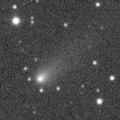
|
It brightened up to 13.8 mag in spring (Apr. 26, Thomas Lehmann). Now it is 16.3 mag (Sept. 22, ATLAS South Africa). Fading slowly. It will be fainter than 18 mag in November. In the Northern Hemisphere, it will never be observable after this. It locates somewhat low in the Southern Hemisphere.
Date(TT) R.A. (2000) Decl. Delta r Elong. m1 Best Time(A, h)
Oct. 14 16 12.43 -40 50.5 3.165 2.660 51 17.1 18:51 ( 42, -5)
Oct. 21 16 27.96 -41 12.0 3.243 2.680 47 17.3 18:43 ( 42, -6)
|
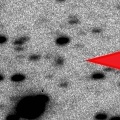
|
Now it is 17.7 mag (Sept. 14, Jean-Claude Merlin). It stays 17 mag for a while. In the Northern Hemisphere, it is not observable now, but it will appear in January. In the Southern Hemisphere, it will be getting lower gradually after this, and it will be unobservable in November. But it will be observable again in December. It stays 16 mag in the Southern sky for a long time from 2024 to 2025.
Date(TT) R.A. (2000) Decl. Delta r Elong. m1 Best Time(A, h)
Oct. 14 16 23.92 -39 32.0 6.841 6.289 52 17.2 18:51 ( 41, -2)
Oct. 21 16 24.98 -39 34.1 6.902 6.261 46 17.2 18:43 ( 44, -5)
|

|
Now it is 17.6 mag (Sept. 26, ATLAS-HKO, Haleakala). It stays 17 mag for a while. In the Northern Hemisphere, it stays observable in good condition. It stays extremely low in the Southern Hemisphere.
Date(TT) R.A. (2000) Decl. Delta r Elong. m1 Best Time(A, h)
Oct. 14 5 10.16 38 58.3 4.768 5.321 118 17.3 3:43 (180, 86)
Oct. 21 5 9.80 38 49.9 4.658 5.299 125 17.2 3:15 (180, 86)
|
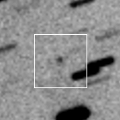
|
Now it is 17.5 mag (Sept. 28, Ken-ichi Kadota). It stays 17 mag for a while. In the Northern Hemisphere, it stays observable in good condition. In the Southern Hemisphere, it is not observable now, but it will appear in November.
Date(TT) R.A. (2000) Decl. Delta r Elong. m1 Best Time(A, h)
Oct. 14 0 36.59 58 6.4 3.720 4.419 129 17.3 23:04 (180, 67)
Oct. 21 0 15.06 57 20.6 3.692 4.402 130 17.3 22:15 (180, 68)
|

|
Now it is 17.6 mag (Sept. 27, ATLAS Chile). It stays 17 mag for a while. It stays extremely low in the Northern Hemisphere. In the Southern Hemisphere, it stays observable in good condition.
Date(TT) R.A. (2000) Decl. Delta r Elong. m1 Best Time(A, h)
Oct. 14 5 16.25 -38 36.1 7.614 7.966 107 17.4 3:48 ( 0, 16)
Oct. 21 5 15.71 -39 9.7 7.551 7.941 109 17.4 3:20 ( 0, 16)
|

|
It brightened up to 13.4 mag in last summer (July 7, 2022, Giuseppe Pappa). Now it is 17.4 mag (Sept. 7, Thomas Lehmann). It stays 18 mag for a while. It locates somewhat low in the Northern Hemisphere. But it will become high in winter. In the Southern Hemisphere, it will never be observable after this.
Date(TT) R.A. (2000) Decl. Delta r Elong. m1 Best Time(A, h)
Oct. 14 15 32.56 29 11.6 5.342 4.760 49 17.4 18:51 (106, 30)
Oct. 21 15 36.13 29 7.9 5.411 4.808 48 17.5 18:43 (108, 27)
|
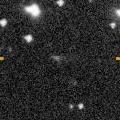
|
First return of a new periodic comet which brightened up to 15 mag in 2008. Now it is 18.8 mag (Sept. 23, A. Diepvens). It will fade out rapidly after this. It will be fainter than 18 mag in November. It stays observable in good condition.
Date(TT) R.A. (2000) Decl. Delta r Elong. m1 Best Time(A, h)
Oct. 14 4 8.32 13 49.9 1.880 2.696 136 17.7 2:41 ( 0, 69)
Oct. 21 4 6.18 12 22.8 1.855 2.725 144 17.8 2:11 ( 0, 68)
|

|
Now it is 18.7 mag (Oct. 3, Catalina Sky Survey). It will brighten rapidly after this. It stays observable in good condition.
Date(TT) R.A. (2000) Decl. Delta r Elong. m1 Best Time(A, h)
Oct. 14 0 32.01 4 44.2 0.801 1.791 169 18.0 23:01 ( 0, 60)
Oct. 21 0 22.68 2 29.8 0.752 1.720 159 17.7 22:24 ( 0, 57)
|

|
It brightened up to 14 mag from 2020 to 2021. Now it is 17.9 mag (Aug. 24, W. Hasubick). It stays 18 mag for a while. It stays observable in good condition.
Date(TT) R.A. (2000) Decl. Delta r Elong. m1 Best Time(A, h)
Oct. 14 2 57.96 3 14.5 3.849 4.764 153 17.9 1:31 ( 0, 58)
Oct. 21 2 53.99 2 59.0 3.826 4.775 160 17.9 0:59 ( 0, 58)
|
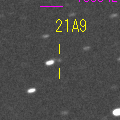
|
Now it is 18.9 mag (Sept. 25, W. Hasubick). It stays 18 mag for a while. It stays observable in good condition.
Date(TT) R.A. (2000) Decl. Delta r Elong. m1 Best Time(A, h)
Oct. 14 7 43.28 10 58.6 7.800 7.766 84 18.0 4:40 (312, 58)
Oct. 21 7 41.44 10 43.8 7.672 7.764 91 17.9 4:46 (327, 62)
|

|
It returned for the first time in 68 years. It will brighten up to 7.5 mag in 2024 summer. Now it is 19.8 mag (Sept. 27, J. Nicolas, F. Kugel). It will brighten rapidly after this. It stays observable in good condition. At the high light, it locates low in the Northern Hemisphere, or it is not observable in the Southern Hemisphere.
Date(TT) R.A. (2000) Decl. Delta r Elong. m1 Best Time(A, h)
Oct. 14 4 23.81 -19 26.3 2.843 3.522 125 18.8 2:56 ( 0, 36)
Oct. 21 4 20.08 -20 5.0 2.725 3.453 130 18.5 2:25 ( 0, 35)
|
|
![]()
 C/2017 K2 ( PanSTARRS )
C/2017 K2 ( PanSTARRS ) C/2021 T4 ( Lemmon )
C/2021 T4 ( Lemmon ) C/2023 S2 ( ATLAS )
C/2023 S2 ( ATLAS ) C/2019 U5 ( PanSTARRS )
C/2019 U5 ( PanSTARRS ) C/2023 E1 ( ATLAS )
C/2023 E1 ( ATLAS ) 62P/Tsuchinshan 1
62P/Tsuchinshan 1 C/2019 L3 ( ATLAS )
C/2019 L3 ( ATLAS ) C/2022 A2 ( PanSTARRS )
C/2022 A2 ( PanSTARRS ) 29P/Schwassmann-Wachmann 1
29P/Schwassmann-Wachmann 1 C/2021 X1 ( Maury-Attard )
C/2021 X1 ( Maury-Attard ) C/2020 K1 ( PanSTARRS )
C/2020 K1 ( PanSTARRS ) C/2022 JK5 ( PanSTARRS )
C/2022 JK5 ( PanSTARRS ) C/2022 E2 ( ATLAS )
C/2022 E2 ( ATLAS ) 126P/IRAS
126P/IRAS C/2022 L2 ( ATLAS )
C/2022 L2 ( ATLAS ) C/2019 T4 ( ATLAS )
C/2019 T4 ( ATLAS ) C/2021 G2 ( ATLAS )
C/2021 G2 ( ATLAS ) C/2023 A3 ( Tsuchinshan-ATLAS )
C/2023 A3 ( Tsuchinshan-ATLAS ) C/2021 Y1 ( ATLAS )
C/2021 Y1 ( ATLAS ) 213P/Van Ness
213P/Van Ness 32P/Comas Sola
32P/Comas Sola 471P/2023 KF3
471P/2023 KF3 199P/Shoemaker 4
199P/Shoemaker 4 C/2022 E3 ( ZTF )
C/2022 E3 ( ZTF ) C/2022 S4 ( Lemmon )
C/2022 S4 ( Lemmon ) 237P/LINEAR
237P/LINEAR C/2023 K1 ( ATLAS )
C/2023 K1 ( ATLAS ) 144P/Kushida
144P/Kushida 226P/Pigott-LINEAR-Kowalski
226P/Pigott-LINEAR-Kowalski 117P/Helin-Roman-Alu 1
117P/Helin-Roman-Alu 1 C/2014 UN271 ( Bernardinelli-Bernstein )
C/2014 UN271 ( Bernardinelli-Bernstein ) C/2022 A3 ( Lemmon-ATLAS )
C/2022 A3 ( Lemmon-ATLAS ) C/2020 Y2 ( ATLAS )
C/2020 Y2 ( ATLAS ) 71P/Clark
71P/Clark 81P/Wild 2
81P/Wild 2 C/2022 W3 ( Leonard )
C/2022 W3 ( Leonard ) P/2023 M4 ( ATLAS )
P/2023 M4 ( ATLAS ) C/2019 E3 ( ATLAS )
C/2019 E3 ( ATLAS ) C/2021 S4 ( Tsuchinshan )
C/2021 S4 ( Tsuchinshan ) C/2022 N2 ( PanSTARRS )
C/2022 N2 ( PanSTARRS ) C/2022 QE78 ( ATLAS )
C/2022 QE78 ( ATLAS ) 219P/LINEAR
219P/LINEAR C/2022 V2 ( Lemmon )
C/2022 V2 ( Lemmon ) 170P/Christensen
170P/Christensen 2019 AV4
2019 AV4 77P/Longmore
77P/Longmore C/2023 F3 ( ATLAS )
C/2023 F3 ( ATLAS ) C/2022 U3 ( Bok )
C/2022 U3 ( Bok ) C/2022 U1 ( Leonard )
C/2022 U1 ( Leonard ) C/2022 R6 ( PanSTARRS )
C/2022 R6 ( PanSTARRS ) C/2020 R7 ( ATLAS )
C/2020 R7 ( ATLAS ) 465P/2023 L1 ( Hill )
465P/2023 L1 ( Hill ) 207P/NEAT
207P/NEAT 246P/NEAT
246P/NEAT C/2021 A9 ( PanSTARRS )
C/2021 A9 ( PanSTARRS ) 13P/Olbers
13P/Olbers![]()

























































